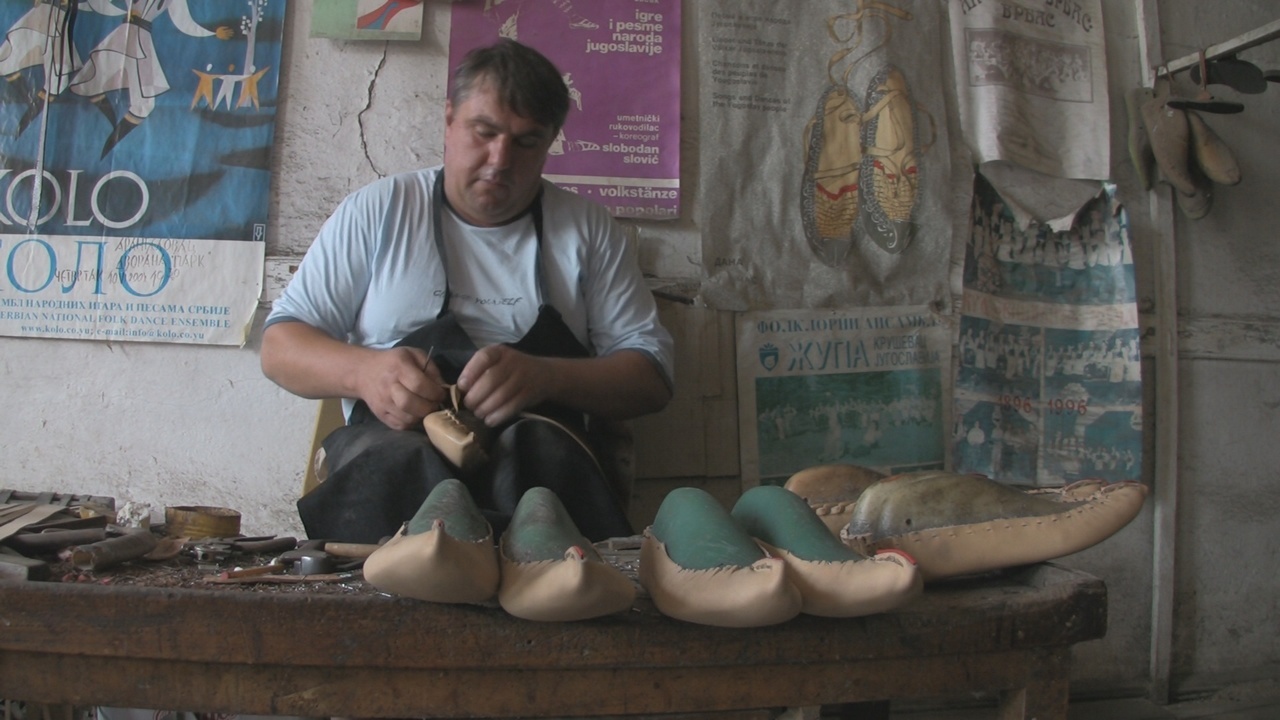Peasant
Sandals Making
location: Natalinci, Topola
The need for clothing and footwear among humans has its origin in the dawn of civilization, when they “parted” from nature and start creating culture. Sandals making emerges in the period when humans became conscious beings and started making their “new nature” i.e. culture. Traditional peasant sandals (“opanci”) today enjoy the status of a privileged symbol of traditional Serbian culture and national identity. The roots of modern sandals making craft can be traced back to the Medieval (Byzantine and Western European) cultural tradition. This craft has it expansion in the second half of the nineteenth and the first half of the twentieth century. After the Second World War, especially after the 1950’s and 1960’s this craft almost completely disappears.
The majority of sandals making stores in urban areas existed in the regions of Pozarevac, Sabac, Uzice, Valjevo and Cacak, where several types of peasant sandals and a number of local versions were produced. Traditional sandals makers existed in other areas as well, and particularly skilled were those from the settlement Natalinci in Topola Municipality. In smaller rural settlements, in was not uncommon for self-taught individuals to practise traditional sandals making, as a form of supplementary activity or a source of additional income. In the Southern and South-western parts of the country (regions of Raska and Metohija, southeast and east Serbia) two main types of “raw” traditional sandals (“presni opanci”) were made: vrncani and presnjaci, and in the Eastern and Northern Serbia traditional sandals with soles (“djonovski opanci” and “opanci kapicari”) were also made.
At the time of expansion of traditional sandals making craft in Serbia, Serbian craftsmen participated at international fairs in Paris, London, Vienna and Budapest. Thanks to this fact, Serbian traditional sandals can nowadays be seen in the museum collections throughout the world.
The making of peasant sandals requires the knowledge of tanning (pig, sheep, lamb skin), as well as knitting and modelling sandals.
According to tradition, the Serbs were introduced to the skills of tanning by Saint Sava, and thus traditional sandal makers considered him as their protector and celebrated St. sava’s Day („Savindan“).
There are relicts of this archaic craft today, used mostly in making shoes for cultural and artistic groups or products sold as souvenirs.
The majority of sandals making stores in urban areas existed in the regions of Pozarevac, Sabac, Uzice, Valjevo and Cacak, where several types of peasant sandals and a number of local versions were produced. Traditional sandals makers existed in other areas as well, and particularly skilled were those from the settlement Natalinci in Topola Municipality. In smaller rural settlements, in was not uncommon for self-taught individuals to practise traditional sandals making, as a form of supplementary activity or a source of additional income. In the Southern and South-western parts of the country (regions of Raska and Metohija, southeast and east Serbia) two main types of “raw” traditional sandals (“presni opanci”) were made: vrncani and presnjaci, and in the Eastern and Northern Serbia traditional sandals with soles (“djonovski opanci” and “opanci kapicari”) were also made.
At the time of expansion of traditional sandals making craft in Serbia, Serbian craftsmen participated at international fairs in Paris, London, Vienna and Budapest. Thanks to this fact, Serbian traditional sandals can nowadays be seen in the museum collections throughout the world.
The making of peasant sandals requires the knowledge of tanning (pig, sheep, lamb skin), as well as knitting and modelling sandals.
According to tradition, the Serbs were introduced to the skills of tanning by Saint Sava, and thus traditional sandal makers considered him as their protector and celebrated St. sava’s Day („Savindan“).
There are relicts of this archaic craft today, used mostly in making shoes for cultural and artistic groups or products sold as souvenirs.
back to home page


